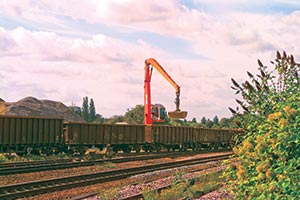STB Proposes to Restore Rail Regulation for Steel, Coke, Stone, Other Commodities

This story appears in the April 4 print edition of Transport Topics.
The Surface Transportation Board is asking for comments on a proposal to restore rail regulatory oversight for cement, steel, scrap, coke, crushed stone and gravel shipments, citing a rise in rail market power and rates for that freight.
The agency is seeking comments by May 27 on the proposal, which could bring about 1.8 million shipments, or 6% of current annual rail traffic, back under the agency’s regulatory authority. It also has asked for comment on other commodities where regulatory exemptions could be discontinued.
“The objective of the proposed rule is to restore shippers’ access to the board’s regulatory oversight and processes — in particular, shippers of those commodities where evidence indicates that the competitive landscape has changed significantly enough to indicate that renewed regulation is needed,” the agency’s notice said.
In the 1980s, the commodities in the current proceeding were exempted from regulation. Truck-rail freight, which now comprises half of rail shipments, also was deregulated. STB maintains its authority to regulate rates for coal, grain and chemicals that account for nearly 40% of rail revenue.
STB is resuming a review that was undertaken five years ago but did not lead to any changes. The announcement was sparked by a more recent staff review of rate and market share trends between 1992 and 2013, which determined that railroads had both growing control and pricing leverage for those commodities in some markets.
STB measures pricing power using revenue and variable costs, known as an R/VC ratio. If the ratio is below 180, STB has no legal authority to hear arguments about rates. When the ratio is above that level, the agency gains jurisdiction to hear rate disputes but does not automatically have to find that the rates are too high.
In the case of iron and steel products, the R/VC ratio increased 8% to 236.6, and for scrap, it rose 2% to 229.8. Crushed stone ratios rose 10% to 254.9, and cement increased nearly 15% to 239.6. For coke, the rise was 10% to 248.5.
Industry comment on the proposal was mixed.
“Given the consolidation in the railroad industry since deregulation and lack of competition in certain lanes, and for some commodities, it may be an appropriate time for the STB to review whether the original intent of the Staggers Act is being met by existing policies,” said Dave Osiecki, American Trucking Associations’ executive vice president of national advocacy.
Association of American Railroads spokesman Ed Greenberg said, “AAR is carefully reviewing details of the proposed rule.”
He added, “In 2011, the AAR expressed serious reservations with the board over its review of certain commodity exemptions. The exemptions have led to enhanced competition, enhanced service offerings, and increased productivity and efficiency, which continue to benefit rail customers today.”
“The Freight Rail Customer Alliance views this as a very positive step,” said Ann Warner, director of the shipper group. “We have long supported allowing those commodities or products that are not allowed [or exempt] to go before the STB to seek rate relief.”
National Industrial Transportation League Executive Director Jennifer Hedrick said STB’s action “is a move forward,” adding that “railroads’ finan- cial strength today did not support the continuation of the exemptions.”
The agency offered the potential alternative of a continued regulatory exemption for the commodities among some or all smaller railroads, whose revenue could be disproportionately affected by rate adjustments.
STB Chairman Daniel Elliott and Vice Chairman Deb Miller supported the proposal, but Commissioner Ann Begeman dissented, saying the factual record used to justify the review was too old.
“I am not convinced that [staff] analysis sufficiently supports altering the exemption landscape,” she said.

